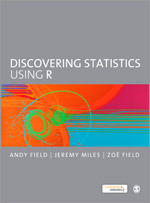Discovering Statistics Using R
- Andy Field - University of Sussex, UK
- Jeremy Miles - RAND Corporation, USA
- Zoë Field - University of Sussex, UK
Keeping the uniquely humorous and self-deprecating style that has made students across the world fall in love with Andy Field's books, Discovering Statistics Using R takes students on a journey of statistical discovery using R, a free, flexible and dynamically changing software tool for data analysis that is becoming increasingly popular across the social and behavioural sciences throughout the world.
The journey begins by explaining basic statistical and research concepts before a guided tour of the R software environment. Next you discover the importance of exploring and graphing data, before moving onto statistical tests that are the foundations of the rest of the book (for example correlation and regression). You will then stride confidently into intermediate level analyses such as ANOVA, before ending your journey with advanced techniques such as MANOVA and multilevel models. Although there is enough theory to help you gain the necessary conceptual understanding of what you're doing, the emphasis is on applying what you learn to playful and real-world examples that should make the experience more fun than you might expect.
Like its sister textbooks, Discovering Statistics Using R is written in an irreverent style and follows the same ground-breaking structure and pedagogical approach. The core material is augmented by a cast of characters to help the reader on their way, together with hundreds of examples, self-assessment tests to consolidate knowledge, and additional website material for those wanting to learn more.
Given this book's accessibility, fun spirit, and use of bizarre real-world research it should be essential for anyone wanting to learn about statistics using the freely-available R software.
Supplements
This is an engaging and entertaining book and has to be one of the easiest to follow.
Just like the SPSS book it is fun to read and a good overview. BUT: although R is a free and increasingly wide-spread, it is sometimes a little hard to get used to it, especially if you switch from some other software package (S...).
So, I just recommend this book for some procedures (robust tests etc.) that can not be done in SPSS and for those of my students who like to learn using R which I strongly encourage. For this endeavor this book is a great help. So it's not the book's fault that it just supplemental material in my course, but the time is not yet ripe for a full switch to R in our department.
I like the book very much and I recommended it to the students who want to switch to R for all their statistical needs. However, currently, most statistics are still taught in SPSS at the BSI at Radboud University and only the "mixed/multilevel" course was taught in R. The problem with the respective chapter in this otherwise great book is that Andy Fields explains the use of the nlme library, which is a somewhat outdated/older library for that type of model. For a while, there has now been a newer package (lme4; actually by the same developer(s), which is more advanced). Accordingly, I taught the students how to use lme4 and therefore the book was not as helpful for mixed/multilevel models as it could have been.
Field brings his unique and engaging writing to the R environment. Wonderful book, and necessary for anyone preparing for the R revolution that is burgeoning at the feet of SPSS and SAS. However, many students are not quite versed enough in programming to be able to get through this in a semester. If a statistics sequence incorporated programming over the course of two or three semesters, I would highly recommend this text.
Decided to stick with the SPSS version for now - but may move toward R in the future.
Andy Field's book is a very good introduction to statistics for undergraduates.
Very accessible introduction to Statistics and good link into R. Good to see a number of worked examples.
It was a very good text with detailed step-by-step usage of R. Loved it!
The research department thinks it is not suitable for our students.
This is a very user friendly book on R. It facilitated my learning and the use of the R. It was written an a level that my students could also understand.









